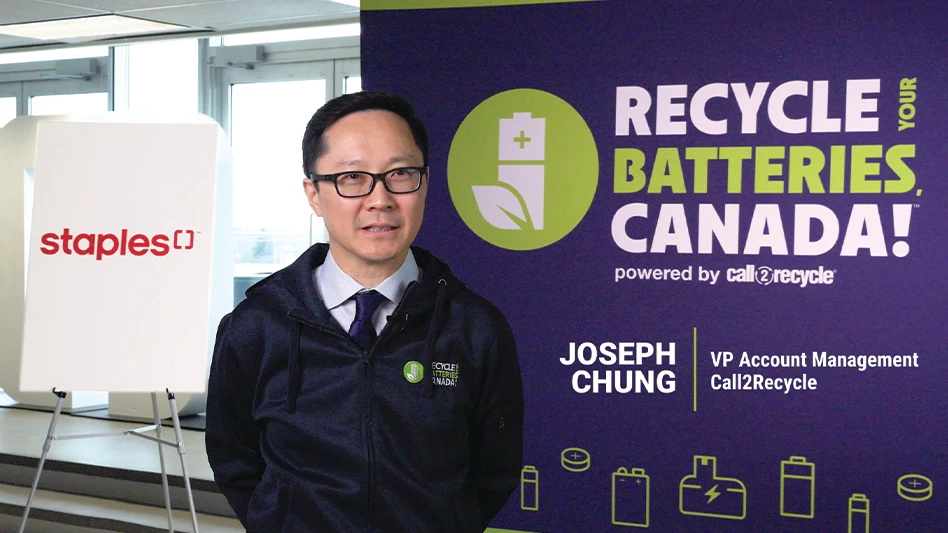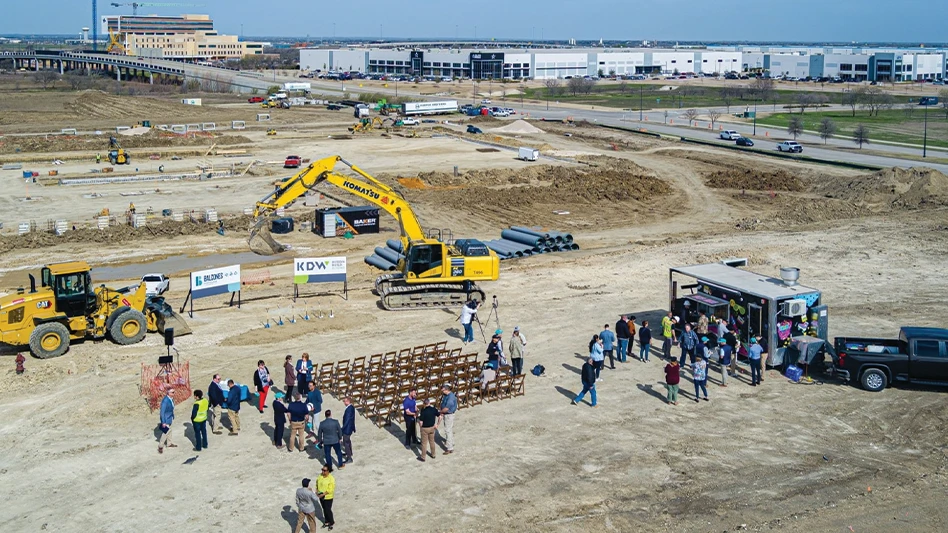 In November 2013, Recycling Today’s sister publication Renewable Energy from Waste magazine partnered with Gershman, Brickner & Bratton (GBB) and Smithers Apex to produce the inaugural Renewable Energy from Waste Conference. Information-packed sessions covered all aspects of waste conversion technologies, while more than 200 attendees listened and asked questions.
In November 2013, Recycling Today’s sister publication Renewable Energy from Waste magazine partnered with Gershman, Brickner & Bratton (GBB) and Smithers Apex to produce the inaugural Renewable Energy from Waste Conference. Information-packed sessions covered all aspects of waste conversion technologies, while more than 200 attendees listened and asked questions.
The keynote sessions offered insights from experts in the field on where the industry is headed and what has led to successes and failures in the adoption of waste conversion technologies over more traditional disposal options.
Conference Co-chair Harvey Gershman, president, GBB, Fairfax, Va., opened the proceedings by getting attendees up to speed on the status of the waste-to-energy (WTE) industry in North America.
Cchange is afoot
Gershman said many changes are taking place across the country on the collection side of the waste and recycling business. He referenced many communities shifting to single-stream collection over the last five years and other communities, such as Houston and Montgomery, Ala., that are considering one-bin collection. Many other communities have two-, three- or four-bin systems. More of an emphasis is being placed on commercial food scrap collection as well, he said.
“More and more communities are adding residential food scraps,” Gershman said. “The growth of commercial food waste collection programs is dramatic in the U.S.”
Gershman emphasized that the cost of collection is two-thirds the cost customers pay for solid waste management. One-third of the cost is related to what happens to the waste after it is collected. “So if you have an inefficient system, or you are layering on services, you are looking at adding significant cost,” Gershman said.
If a solid waste management system can save money by making the collection more efficient, he said, those funds can be redirected toward the processing of the materials, including making renewable energy from waste.
GBB is tracking 579 companies that offer various waste conversion technologies. Worldwide 150 plants are operating with some of these technologies, said Gershman. He said one reason for doing something other than building a traditional waste-to-energy (WTE) plant to make electricity is that making ethanol or methanol can generate more revenue; but, he warned, the economics have to be competitive with the alternative disposal options.
Many of the projects implemented in the United States have been aided by federal funding. He noted mass-burn facility expansions in Hillsborough County and Lee County, Fla.; Olmsted County, Minn., and Honolulu; as well as facilities under construction in the Durham-York region of Ontario and in Palm Beach County, Fla.
As for gasification, Gershman mentioned Covanta’s commercial-scale demonstration unit in Tulsa, Okla.; the Ineos Indian River County BioEnergy Center in Vero Beach, Fla.; Enerkem’s facility under construction in Edmonton, Alberta; Fulcrum BioEnergy’s Sierra BioFuels commercial plant under construction in McCarran, Nev.; and Plasco Energy’s commercial-scale demonstration facility and contract with the city of Ottawa, Ontario. Fiberright, a company using fermentation to process municipal solid waste, operates a demonstration plant in Lawrenceville, Va.; is working on facilities in Blairstown, Iowa, and Elkridge, Md.; and has a contract with the city of Marion, Iowa.
Gershman also noted 19 anaerobic digesters in North America processing food waste and a well-established landfill-gas-to-energy industry. Projects that combine the gas produced from both technologies could provide more opportunity for biogas, he said.
Gershman also discussed was mechanical biological processing (MBT), which is taking place in Germany. He referenced a conference he attended in that country in June, saying, “It gave me a good perspective on what is going on there and how it relates to our situation here.”
Gershman Germany started using MBT in 1999 and that the country now has 36 MBT plants.
 “They decided they don’t want any organics going to landfill, so they came up with this concept to process primarily the residential waste into several fractions,” Gershman explained. Those fractions include recyclables, fuel, organics, mixed waste and biogas from mixed waste.
“They decided they don’t want any organics going to landfill, so they came up with this concept to process primarily the residential waste into several fractions,” Gershman explained. Those fractions include recyclables, fuel, organics, mixed waste and biogas from mixed waste.
He noted that several European countries have less than 3 percent of waste going to landfills. They accomplish this by taxing landfills and creating an economic ceiling under which a lot of technologies could operate, he said.
Gershman said material recovery facilities (MRFs) and MBT plants look similar, with advanced processing equipment like infrared sorters, eddy currents and trommels. He said the technology is coming to America and some of it is already here.
Gershman concluded by summing up the regulatory climate in the U.S. for energy from waste. “We need better federal and state laws and regulations that allow more renewable energy from waste to happen and with economics that we can afford to make them happen,” he said.
Pitfalls and lessons
Delay tactics and economic deal-breakers are two major pitfalls to watch out for when bringing a WTE project to completion, according to keynote presenters during the second day’s proceedings. Speakers for the “Pitfalls and Challenges” session referred to what they described as delay strategies launched by opposition groups apparently intended to slow or stop the projects.
Mark Hammond, executive director of the Solid Waste Authority (SWA) of Palm Beach County, discussed that agency’s experience, which was at the time about 60 percent through construction of its second WTE facility, a mass-burn plant that will handle 3,000 tons of municipal solid waste per day.
The new plant is being built on the SWA’s existing campus of about 1,300 acres, which includes landfills, a MRF and an RDF (refuse-derived fuel) WTE plant.
Plans for the new facility were approved after SWA determined in 2005 that its landfill could be depleted by 2025. “We began a search for a new landfill,” Hammond said. However, that initiative was not successful as a result of siting issues, so the SWA’s board instead decided to refocus efforts on expanding WTE at the current facility.
“We didn’t build this to generate power,” he said. “WTE for us is a volume-reduction machine that happens to make power.”
Although Hammond said the “stars and planets were seemingly aligned” for most of the project, the team did encounter opposition from The Sierra Club three or four years into the project, when the group asked for a review of alternative waste disposal methods.
SWA retained the help of consulting firm GBB, Hammond said, and prepared what he calls a swift, informed response to refute the group’s statements. “We had invested millions of dollars, and the thought that someone would come in at the 11th hour and try to scuttle the project was shocking to us, and we weren’t going to take it lightly,” Hammond said.
Similarly, speaker Pete Johnson, vice president of Dynamis Energy, based in Eagle, Idaho, described the use of apparent delay tactics on the part of opposition groups in Ada County, Idaho, that were ultimately successful in putting an end to that county’s WTE project.
In 2010 Dynamis won the contract to build a mobile gasification system at the Ada County Landfill to help extend the facility’s life. The company also negotiated an agreement with Idaho Power amounting to the delivery of 20 megawatts of power for close to 10 cents per kilowatt hour.
In advance of permitting from the Idaho Department of Environmental Quality (DEQ), the company held numerous public meetings to provide information on the project, during which Johnson said no major opposition was received.
Then, Johnson said, “two county commissioner seats up were for grabs.” In the ensuing election, “the candidates made our project their campaign platform,” Johnson added. “In a nutshell, all hell broke loose.”
The opposition claimed environmental safety concerns, the use of experimental technologies and improper RFP (request for proposal) processes. The Idaho Conservation League also threatened to bring a lawsuit against the DEQ should the facility be permitted, Johnson said.
 He said he believed these efforts were intended to delay the project to the point of failure. While the company did have community support for the project, he said, its supporters were not nearly as vocal the project’s opponents were.
He said he believed these efforts were intended to delay the project to the point of failure. While the company did have community support for the project, he said, its supporters were not nearly as vocal the project’s opponents were.
“In the end, it’s just very difficult to fight emotion and bias with logic and science,” Johnson said.
Although permitting was eventually granted, it was received six months beyond its contracted delivery date, forcing Dynamis to apply for an extension.
The new rate was 6 cents below the initial amount. “Therein was the demise of the project,” he said. “They effectively took us down by just that simple delay.”
Johnson said if he were to approach a similar project in the future, he would put in place a “micromanagement plan” to better handle DEQ proceedings and deadlines.
Corporate conversion
While conversion technologies sometimes meet with opposition from the public sector, there are several examples of successful use of waste conversion technologies in the corporate arena.
John Winkels of the Kroger Co. Inc., Cincinnati, told attendees that starting an anaerobic digestion (AD) system at the company’s Ralphs/Food 4 Less distribution center in Compton, Calif., yielded a positive return on investment for the grocery store chain.
California’s ban on commercial food waste, in addition to the company’s “zero-waste” goal, prompted Kroger to look at alternatives to food waste disposal. The project offsets about 80 percent of the natural gas used at the distribution facility, Winkels said. Anaerobic digestion also has saved the company the expense of trucking waste to a composting facility two hours away.
“The renewable energy benefit isn’t the majority of the benefit,” he said. “The majority of the benefit is the trucking offset,” Winkels said, noting the project saves Kroger 500,000 miles per year in trucking.
Sorting material for use in the digester also is simpler than prepping it for composting. Any waste containing organic material can be used in the system, he noted.
An additional benefit for Kroger is the customer and associate engagement from the project. “This is something that customers and our associates get excited about,” said Winkels.
“It hasn’t been without growing pains, but it has been operating for over a year now, and we are pleased with the results,” Winkels concluded.
The Renewable Energy from Waste Conference was Nov. 18-20, 2013, at the Marriott West Palm Beach, in West Palm Beach, Fla.
More coverage from the event, including video interviews and clips, will be featured in upcoming issues of Renewable Energy from Waste magazine and at www.REWmag.com.
The authors are managing editors with the Recycling Today Media Group and can be reached at ksmith@gie.net and lmckenna@gie.net. The January/February issue of Renewable Energy from Waste magazine, a sister publication of Recycling Today, features additional conference coverage.

Explore the March 2014 Issue
Check out more from this issue and find your next story to read.
Latest from Recycling Today
- Recycled steel price crosses $500 per ton threshold
- Smithers report looks at PCR plastic’s near-term prospects
- Plastics association quantifies US-EU trade dispute impacts
- Nucor expects slimmer profits in early 2025
- CP Group announces new senior vice president
- APR publishes Design Guide in French
- AmSty recorded first sales of PolyRenew Styrene in 2024
- PRE says EU’s plastic recycling industry at a breaking point





